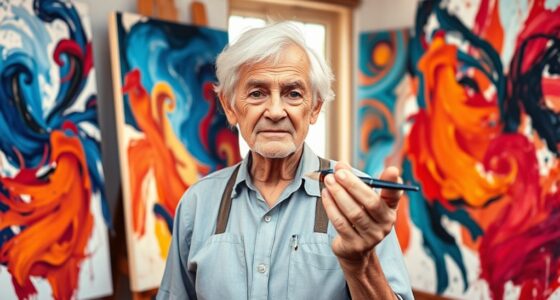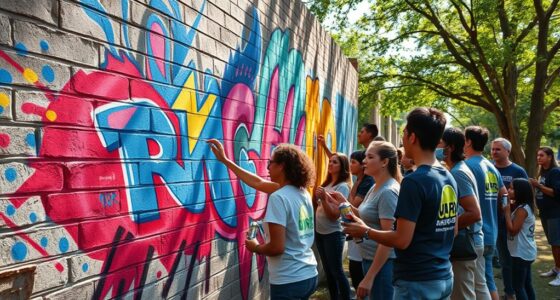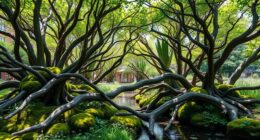Censorship and restrictions on free expression threaten artists worldwide, limiting what you can create and share. Governments and authorities use laws, censorship, and social pressures to silence diverse voices, especially those challenging power, religion, or social norms. Digital platforms can both amplify or suppress your work, and monitoring these violations remains challenging. To understand how ongoing legal, cultural, and technological forces shape artistic freedom—and what you can do to support it—stay with us.
Key Takeaways
- Censorship in the art world is driven by political, religious, and cultural authorities aiming to suppress dissenting or controversial artworks.
- Freedom of expression faces challenges from legal restrictions, societal norms, and institutional pressures that limit artistic innovation and critique.
- Governments and non-state actors use laws, media control, and public shaming to enforce ideological conformity and silence marginalized voices.
- Digital platforms serve as both tools for artistic resistance and targets of censorship, affecting artists’ ability to share and critique freely.
- Monitoring violations of artistic freedom is complex due to inconsistent reporting, evolving legal frameworks, and artists’ fears of retaliation.
The Growing Global Threats to Artistic Freedom
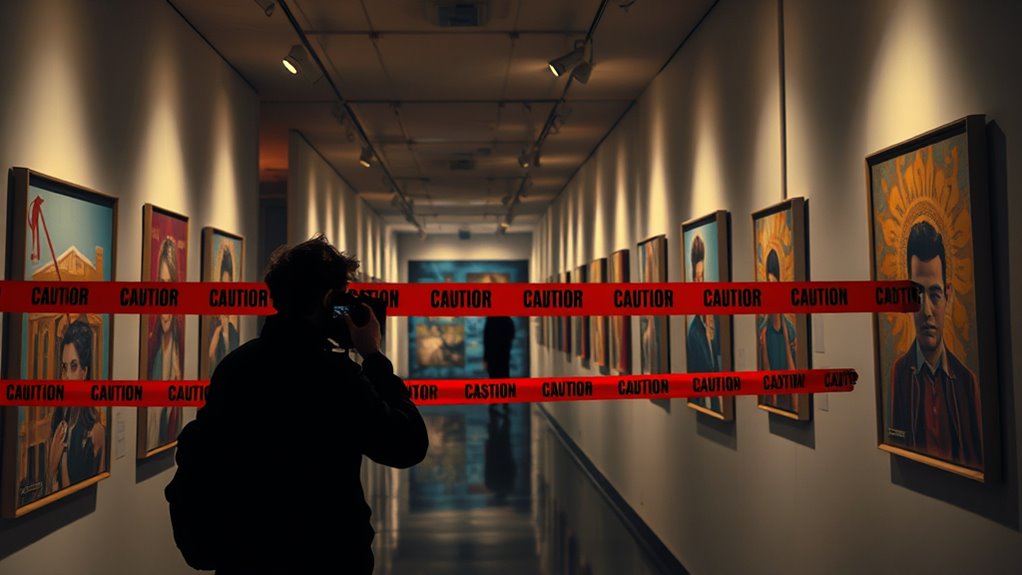
As geopolitical tensions rise and authoritarian regimes tighten control, the threats to artistic freedom have become more pervasive worldwide. You face increasing censorship, arrests, and institutional pressures, especially in sensitive political contexts. Laws are weaponized, with “foreign agent” and anti-terror legislation used to silence dissenting voices. Many artists self-censor out of fear, avoiding topics like political conflicts. Political agendas influence cultural programming, shaping what can be expressed. Beyond governments, organized crime and social media backlash pose serious risks, including threats and smear campaigns. Non-state actors use violence and intimidation to suppress artistic voices, while public opinion and economic pressures lead artists to withdraw or alter their work. These global challenges threaten not only individual creators but also the fundamental role of art in democracy.
Hotspots of Artistic Repression and Suppression
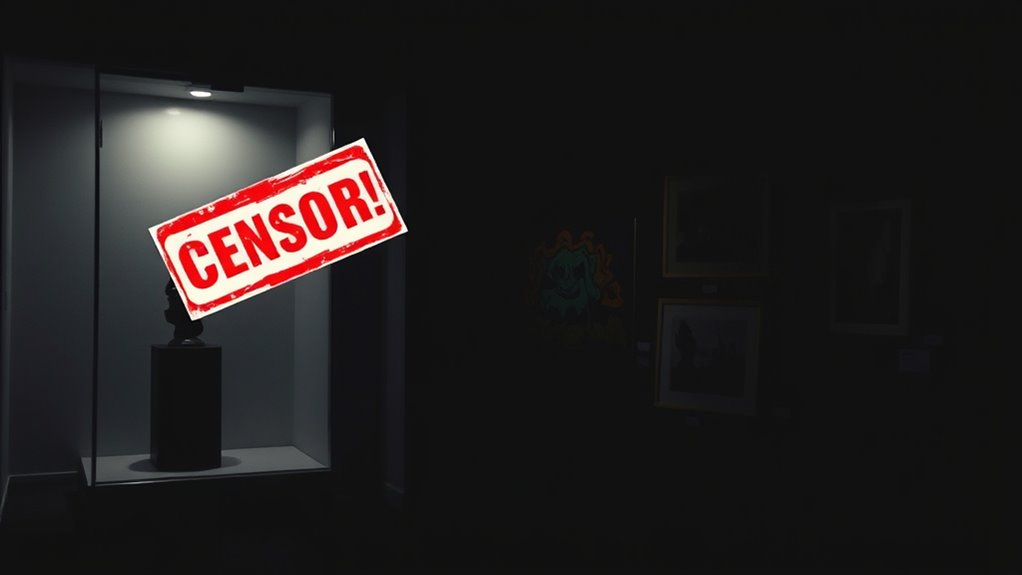
You’ll notice that certain regions become hotspots for artistic repression, where censorship and political pressures intensify. Artists in countries like Iran, China, and Gaza face threats, arrests, and violence simply for expressing themselves. These dangerous environments reveal how geopolitical tensions and violence threaten the very core of artistic freedom. International reports highlight that government crackdowns and legislation are increasingly used to silence dissenting voices in these areas.
Geopolitical Censorship Hotspots
Across various geopolitical hotspots, artists face intense censorship efforts designed to suppress dissent and control cultural narratives. In Iran, strict laws target artworks critical of the government or religious doctrines, leading to arrests and suppression. Middle Eastern autocratic regimes use state-controlled institutions to promote propaganda and silence opposing voices, while conflict zones like Gaza restrict artistic expression amid violence. Saudi Arabia and Qatar utilize cultural events for soft power, but implicit censorship limits politically sensitive themes. Female artists in Afghanistan continue to create privately despite harsh restrictions. In China, the regime enforces rigorous censorship, suppressing works critical of the state, and Hong Kong faces increased restrictions, including the removal of sensitive art. These hotspots exemplify how authoritarian powers manipulate culture to maintain control, stifling artistic freedom worldwide. Censorship efforts are often accompanied by surveillance and intimidation tactics that discourage artists from expressing dissenting views, further entrenching oppressive regimes’ control over cultural spaces. Additionally, the role of creative practice in developing resilience among artists under such repression can be crucial, empowering them to find innovative ways to express themselves despite constraints, including utilizing underground channels and covert activities.
Violence Against Artists
Violence against artists has become an alarming feature of artistic repression worldwide, with reports revealing a sharp rise in attacks, threats, and killings. In 2016, Freemuse documented over 1,000 cases across 78 countries, and by 2021, 39 artists were killed, while more than 500 faced legal actions for challenging authorities or expressing political views. Violent acts include killings, abductions, and physical assaults, often targeting those who criticize governments or push social boundaries. Countries like Afghanistan, Belarus, Myanmar, and Yemen are hotspots, where artists are detained or attacked for activism and dissent. This violence not only silences individual voices but also stifles societal dialogue, creating a climate of fear that hampers artistic freedom and expression worldwide. The increase in documented attacks reflects a growing global concern about the safety of artists.
Legal Measures Used to Curb Artistic Expression
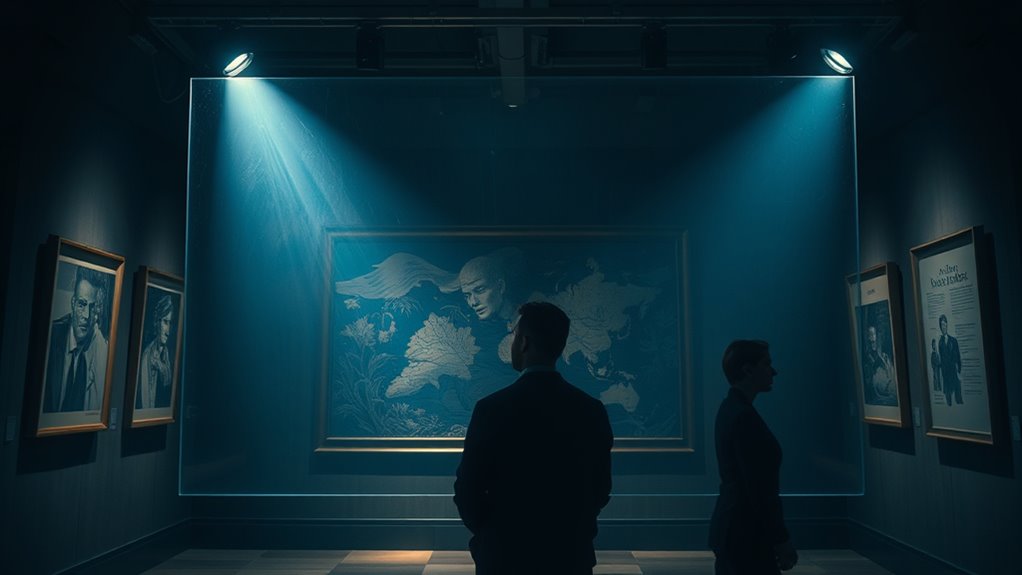
Legal measures aimed at restricting artistic expression often involve a combination of laws and regulations designed to balance freedom of speech with societal interests. You may encounter obscenity laws that restrict art deemed offensive, though these are scrutinized under First Amendment protections. Public decency standards also influence what’s acceptable in public art, varying across locations. Copyright and intellectual property laws can limit how you use or reproduce certain works. Municipal regulations may restrict street art or performances, while private groups can pressure galleries to censor pieces without legal consequences. Here’s an overview:
| Measure | Description | Impact on Artists |
|---|---|---|
| Obscenity Laws | Restrict offensive or obscene art | Limits controversial content |
| Public Decency Laws | Regulate nudity or provocative displays | Affects performance art |
| Copyright Laws | Control reproduction and use of artworks | Restricts derivative works |
| Municipal Regulations | Control art in public spaces | Limits street art and installations |
Additionally, emerging artificial intelligence technologies are raising new questions about originality and authorship in the art world. These evolving technologies introduce novel legal challenges that require ongoing regulation to protect both artists and society. Furthermore, ongoing debates about censorship highlight the complex relationship between artistic freedom and societal norms. Some legal frameworks are being adapted to address these emerging issues, emphasizing the need for legal clarity in the digital age.
How Censorship Affects Creative Work and Artists
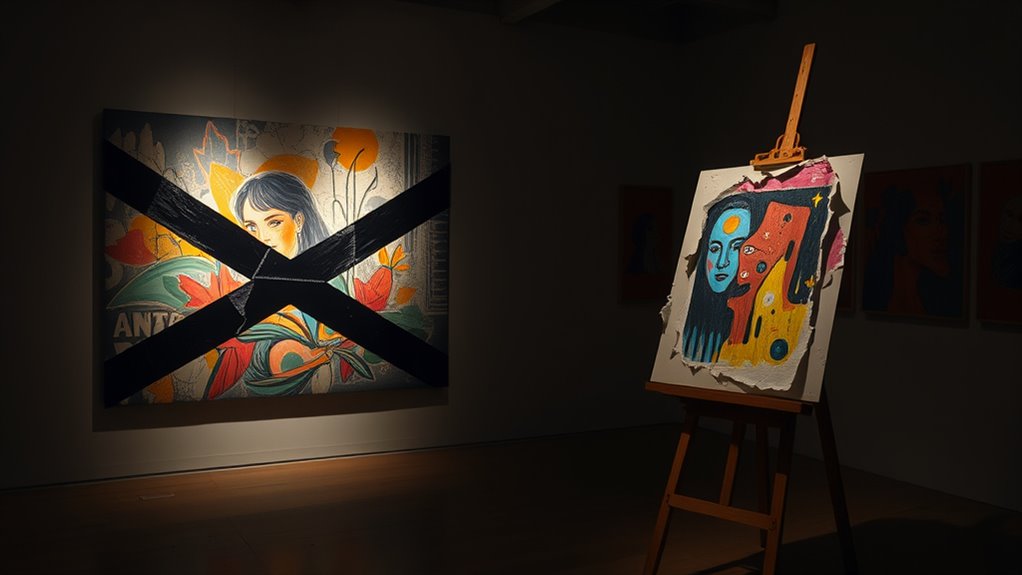
Censorship directly restricts your ability to explore certain topics, limiting creativity and preventing new ideas from emerging. When authorities or gatekeepers block or remove your work, it forces you to alter your message or avoid controversial subjects altogether. This suppression can cause you to compromise your artistic vision, diluting the integrity of your work. Fear of repercussions, such as backlash or punishment, often leads you to self-censor, stifling authentic expression. Across different art forms—visual arts, literature, music, performance, and film—you may face restrictions that curb your freedom and slow societal progress. In the digital age, censorship on social media and online platforms further limits your reach and freedom to share provocative or socially critical work, impacting your career and voice. Additionally, the rise of virtual platforms for hackathons has opened new avenues for artists to connect and showcase their work globally, bypassing some traditional barriers to expression. These innovative digital spaces serve as vital alternative channels for creative voices to thrive despite obstacles. Moreover, ongoing debates about freedom of expression emphasize the importance of protecting artists’ rights to challenge societal norms and provoke thought. Recognizing the role of digital platforms in expanding artistic freedom can empower creators to find new ways to express themselves without censorship. Furthermore, understanding how content moderation policies influence artistic expression is essential for advocating meaningful change.
Challenges in Monitoring and Documenting Violations
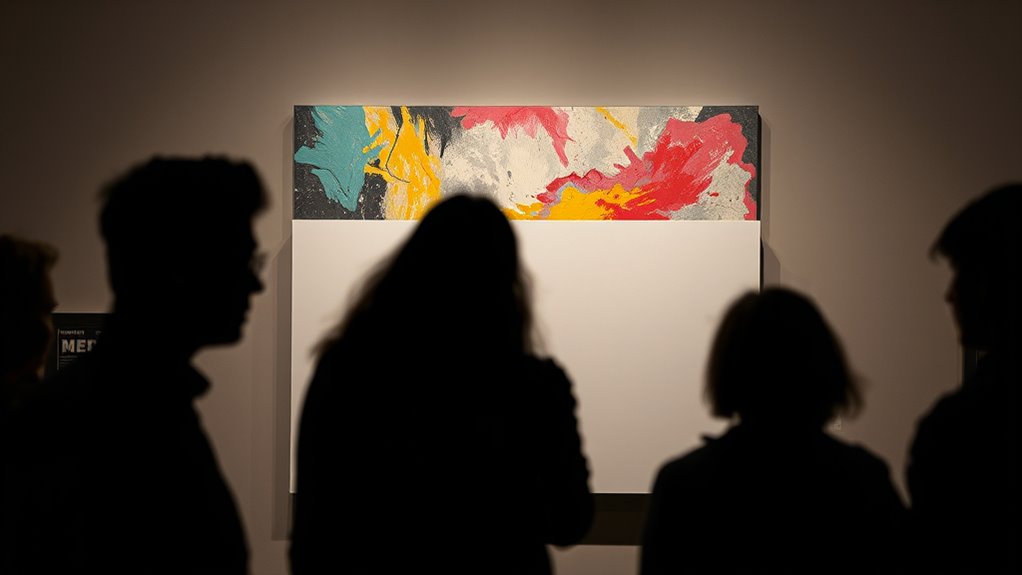
Monitoring and documenting violations of artistic freedom presents significant challenges due to the complex and varied nature of censorship practices. Gathering extensive data is difficult because definitions differ, and reporting methods are inconsistent. State and private actors both engage in censorship, making violations hard to identify and track. Many cases go unreported because artists fear repercussions or lack access to reporting channels. Censorship affects different art forms uniquely, complicating comparisons across mediums. Cultural sensitivities also influence what’s considered censorship, adding another layer of complexity. Analyzing this data demands sophisticated methods to handle factors like internet shutdowns and content blocking. Ensuring data accuracy, scalability, and contextual understanding is essential, but interpreting censorship trends remains difficult due to diverse mechanisms and varying legal frameworks worldwide. Additionally, the history of censorship in different regions influences current practices and perceptions of artistic restrictions. Recognizing the complexity of censorship across diverse societies helps to better understand these challenges. Developing standardized reporting mechanisms can help improve data consistency, but implementing such systems faces significant political and cultural hurdles. Furthermore, advancements in monitoring technologies are crucial for capturing the full scope of these violations and overcoming existing reporting limitations.
The Historical Roots and Cultural Patterns of Censorship

Throughout history, censorship has often served to maintain political or religious authority, shaping what can be expressed in art. Cultural suppression strategies, like strict iconography or state control, reveal how societies have long prioritized social order over individual freedom. Recognizing these patterns helps you understand how essential oils for artistic expression and historical roots influence modern debates over artistic expression today.
Historical Censorship Patterns
Understanding the roots of censorship in art reveals how cultural values and societal norms have historically shaped what you could express. Across ancient civilizations, strict conventions limited artistic freedom:
- Egyptian art adhered to rigid rules, restricting tones and poses.
- Hebrew iconoclasm prohibited graven images, influencing Judeo-Christian and Islamic art.
- Greek and Roman societies had norms that sometimes censored works conflicting with social ideals.
- Medieval religious doctrines heavily censored art perceived as heretical or immoral.
Additionally, cultural norms often dictated what was considered acceptable, reinforcing traditional boundaries for artistic expression. These patterns of censorship were often justified by prevailing moral standards, which served to maintain social order and religious orthodoxy. Throughout history, religious and moral concerns, like the Spanish Inquisition or biblical prohibitions, led to suppression of artworks challenging moral standards. Political regimes, such as Nazi Germany or Communist states, censored art to enforce ideological conformity. Artistic movements like Impressionism or Surrealism also faced censorship for challenging norms. Additionally, art censorship has often been influenced by cultural and societal shifts, reflecting changing attitudes towards freedom of expression. The development of media technology has further complicated censorship debates by introducing new platforms and challenges.
Cultural Suppression Strategies
Cultural suppression strategies have long shaped the boundaries of artistic expression, rooted in historical patterns that reflect deeper societal values. Governments often manipulate legal frameworks, like blasphemy laws, to punish art deemed offensive or controversial. They bypass protections to silence minority voices and install political loyalists in cultural institutions to control narratives. State media amplifies conservative messages while discrediting dissenting art. Bureaucratic mechanisms, such as restructuring arts organizations and withholding funding, serve as leverage to enforce ideological conformity. Non-state actors, including religious groups and right-wing organizations, mobilize public shaming, harassment, and lobbying to pressure censorship. These strategies restrict minority perspectives, promote sanitized narratives, and hinder open debate. As a result, artists face self-censorship, cultural homogenization, and community divisions, all reinforcing the cycle of suppression.
The Role of Digital Platforms in Amplifying or Resisting Censorship

Digital platforms play a dual role in shaping artistic expression by either amplifying voices or enforcing censorship. You’ll notice that social media often limits artists’ reach, especially for emerging creators who face unclear moderation rules. This results in 1) censorship of artwork, 2) limited appeal options, 3) algorithm errors, and 4) suppression of socio-political content. These issues can lead to self-censorship, as artists fear removal or misinterpretation. Online art spaces like virtual galleries and initiatives such as Don’t Delete Art help raise awareness and resist censorship. Digital activism fosters visibility for censored works, but the lack of transparency and inconsistent guidelines hinder meaningful change. Ultimately, these platforms can empower or suppress artistic voices depending on how they handle censorship and advocate for artistic freedom.
Strategies and Movements Defending Artistic Freedom
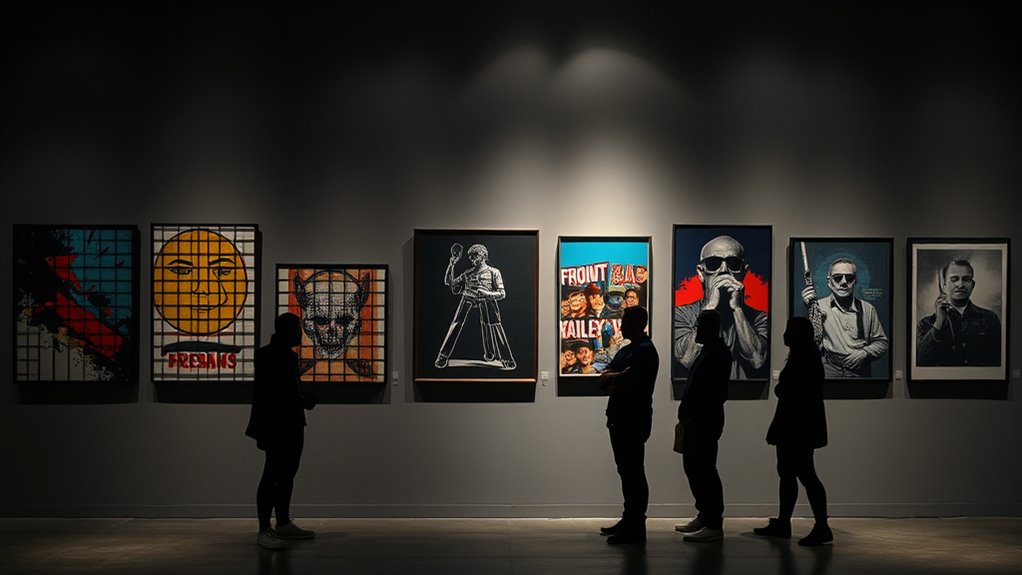
Strategies and movements defending artistic freedom take many forms, from legal advocacy to grassroots activism. You can see legal measures like UNESCO’s 1980 recommendation and international human rights treaties protecting artistic expression. Organizations often file lawsuits to challenge censorship, while lobbyists work to influence laws supporting creative freedom. Artist-led protests, such as exhibitions and public performances, directly confront restrictions and inspire dialogue. Museums and institutions bolster these efforts by safeguarding curatorial independence, hosting safe space exhibitions, and organizing public forums. Campaigns on social media and documentary films raise awareness and rally support. International coalitions like PEN International and Artists at Risk connect artists worldwide, offering residencies, emergency grants, and advocacy reports. Together, these strategies create a resilient network defending the essential role of art in society.
Frequently Asked Questions
How Do Governments Justify Censorship of Artistic Works?
You ask how governments justify censorship of artistic works. Governments often argue that censorship protects societal morals, national security, or public order. They may cite social norms, political sensitivities, or the need to shield vulnerable groups from harm. Sometimes, they claim it’s necessary to preserve cultural standards or prevent offense. While these reasons aim to maintain societal stability, they can conflict with free expression, leading to complex legal and ethical debates.
What Are Effective Ways for Artists to Resist Censorship?
You can resist censorship by leveraging symbolism and subtext, exploiting cultural nuances, and embracing technological tools. Use underground networks and decentralized platforms to share your work globally, avoiding traditional gatekeepers. Collaborate with international artists, employ cryptographic tools for security, and adapt to evolving censorship tactics. Engage your community, utilize social media, and harness digital innovations to spread your message, making censorship harder to control and your voice harder to silence.
How Does Censorship Impact Cultural Diversity and Heritage?
Censorship limits cultural diversity by silencing marginalized voices and erasing controversial histories. You might notice how it reduces exposure to different perspectives, leading to cultural homogenization. It also threatens heritage by suppressing traditional practices and knowledge, causing cultural loss over time. When works are censored, you lose opportunities for meaningful exchange and understanding. To counter this, artists and advocates use digital platforms and activism to preserve and promote diverse cultural expressions.
What Role Do International Organizations Play in Protecting Artistic Freedom?
International organizations play a vital role in safeguarding artistic freedom. They create frameworks like UNESCO’s conventions to promote legal protections, advocate for artists at risk, and influence policy through recommendations. You can rely on their campaigns and reports to raise awareness and support. They also provide direct assistance—legal help, safe havens, and funding—helping artists facing persecution or censorship continue their work and preserve cultural diversity worldwide.
Can Digital Technology Help Circumvent Art Censorship Effectively?
Imagine digital tools as secret tunnels beneath a city, allowing you to bypass guarded gates. These technologies, like encryption and multimedia tunneling, can effectively help you circumvent art censorship. By adapting and leveraging platforms with resistance measures, you can reach broader audiences. However, the complexity of these tools might challenge you, so staying informed and cautious is key to maintaining your creative freedom and ensuring your message flows freely beyond barriers.
Conclusion
As you navigate the complex landscape of artistic freedom, remember that your voice matters. Censorship may threaten creativity, but collective resistance and awareness can make a difference. Will you stand up for the artists whose works challenge the status quo and spark essential conversations? By staying informed and engaged, you help guarantee that art remains a powerful tool for expression, not suppression. After all, isn’t the true art of life found in free expression?


